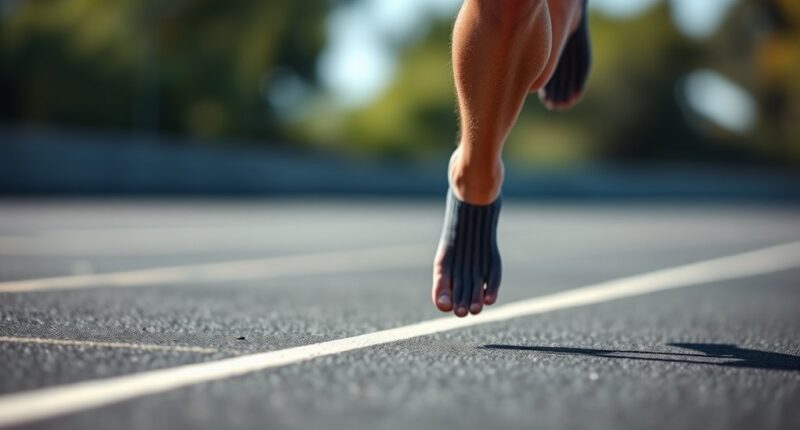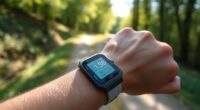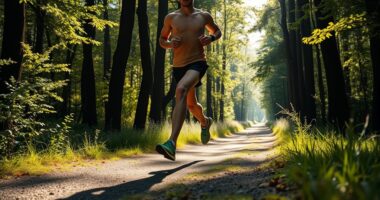Ground-contact time is a key metric that directly affects your running efficiency and injury risk. Shorter contact times mean quicker, more efficient strides, conserving energy and improving performance. Factors like terrain, footwear, and your form influence how long your foot stays on the ground. By measuring and working to reduce this time, you can run more effectively and prevent injuries. Stay with us to discover practical ways to optimize your ground-contact time and boost your runs.
Key Takeaways
- Ground-contact time affects running efficiency, with shorter durations indicating more economical, faster strides.
- Factors like footwear, terrain, and running form influence contact duration; optimizing these can improve performance.
- Longer contact times enhance muscle activation and shock absorption, reducing injury risk and promoting proper gait.
- Measuring contact time through wearable tech or force plates helps identify areas for technique improvement.
- Plyometric and strength training can reduce ground-contact time, leading to better running economy and injury prevention.
Understanding Ground-Contact Time and Its Significance
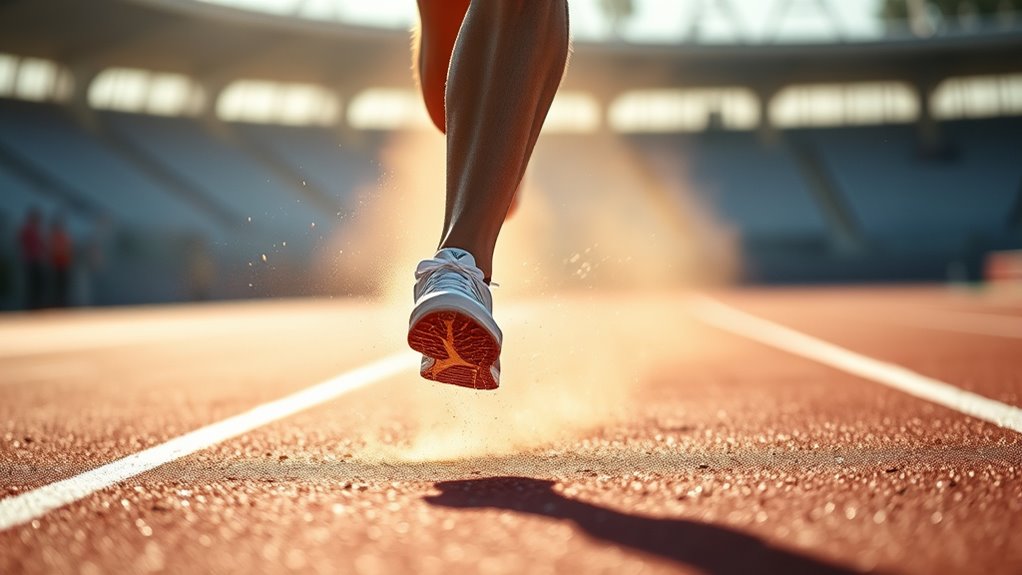
Understanding ground-contact time is essential because it directly affects your running efficiency and performance. When your foot strikes the ground, the duration of contact influences how smoothly you move forward. A shorter ground-contact time usually indicates a quicker, more efficient stride. Your foot strike pattern also plays a role—heel strikers tend to have longer contact times, while forefoot or midfoot strikers often have shorter ones. Shoe cushioning impacts this as well; highly cushioned shoes can increase contact time by providing more shock absorption, potentially slowing your cadence. Recognizing how these factors interact helps you optimize your running form. By reducing unnecessary ground contact, you can improve efficiency, conserve energy, and enhance overall performance during your runs. Additionally, understanding the mechanics of ground-contact time can help you adapt your running technique to improve your running economy. Being aware of contrast ratio and its effect on visual clarity can also be beneficial when setting up your training environment or analyzing your running form in different lighting conditions.
How Ground-Contact Time Reflects Running Efficiency
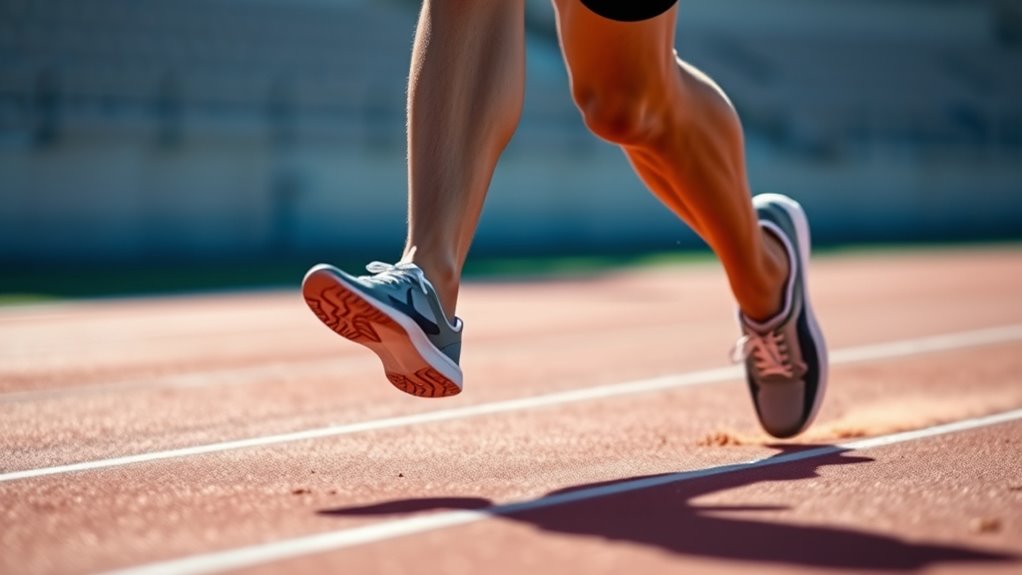
Ground-contact time directly impacts your running efficiency because it determines how quickly your foot shifts from strike to push-off. Shorter contact times mean you’re moving more efficiently, conserving energy with each stride. Factors like shoe cushioning and the running surface influence this timing; softer shoes or uneven terrain can prolong contact, reducing efficiency. When your ground-contact time is optimized, you use less energy, maintain a steadier pace, and avoid fatigue. Consider the following:
| Shoe Cushioning | Running Surface |
|---|---|
| Absorbs shock, but may slow you down | Uneven terrain increases contact time |
| Too soft prolongs contact | Smooth surface shortens contact |
Additionally, understanding the tuning of your running mechanics can help identify areas for improvement, similar to how vehicle tuning enhances performance. Paying attention to ground-contact time during training can help you make necessary adjustments for better efficiency and endurance. Recognizing how foot strike patterns influence contact duration can also provide insight into optimizing your running form. Improving heel strike or midfoot strike techniques can further reduce contact time and enhance overall performance.
The Relationship Between Contact Time and Injury Prevention
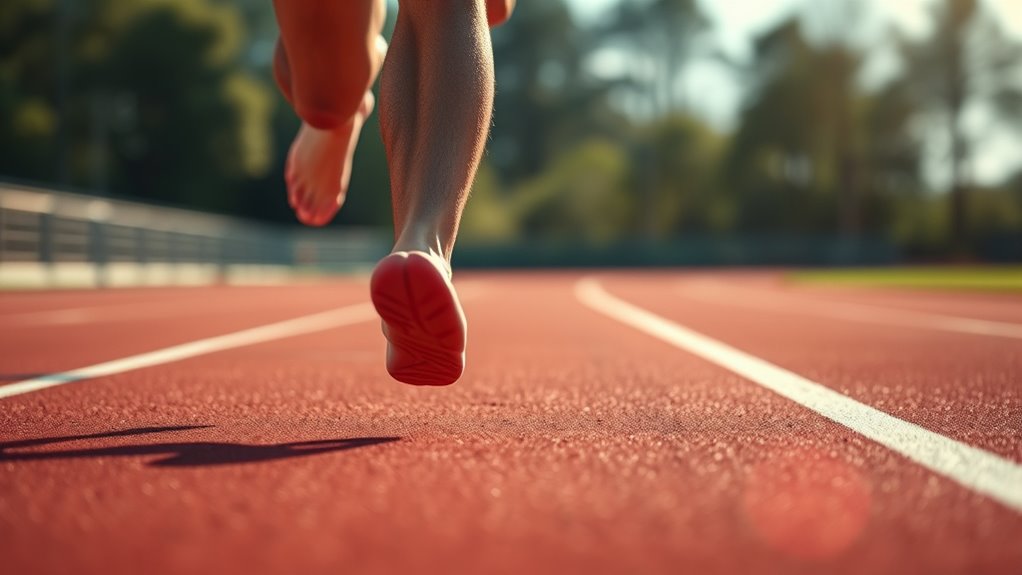
Reducing your ground-contact time can lower impact forces that cause stress on your joints and muscles. This also encourages better muscle activation, helping you move more efficiently and safely. By focusing on these aspects, you can considerably decrease your risk of injuries over time. Incorporating glycolic acid into your skincare routine can also improve skin resilience and recovery from impact-related stress.
Reduced Impact Forces
When your foot stays on the ground longer during each step, it helps absorb shock more effectively, which can substantially lower the impact forces transmitted to your joints. This reduction is vital for injury prevention and relies on understanding running biomechanics. Modern footwear technology enhances this process by providing cushioning and support that promote longer ground contact, allowing your body to distribute forces better. By optimizing your ground-contact time, you decrease the sudden loads that can cause stress fractures, joint pain, and other injuries. Longer contact time encourages a more controlled and efficient stride, helping to minimize peak impact forces. This approach aligns with principles of biomechanical efficiency, which emphasize proper movement mechanics for injury prevention. Focusing on this aspect of running biomechanics can make a significant difference in how your body handles repetitive impacts, ultimately supporting healthier, injury-free running. Additionally, improved active listening during training can help you better recognize how your body responds to different impact levels and adjust accordingly.
Enhanced Muscle Activation
Extended ground contact time allows your muscles to activate more fully during each stride, which enhances stability and control. This increased activation improves muscle recruitment, ensuring that more muscle fibers fire simultaneously to support your movement. As a result, your neuromuscular efficiency improves, meaning your nervous system communicates more effectively with your muscles. With better neuromuscular coordination, you can maintain proper form and adapt quickly to changes in terrain or fatigue. Longer contact times give your muscles the opportunity to engage more thoroughly, reducing the likelihood of compensations or imbalances that can lead to injury. By optimizing muscle activation through appropriate contact time, you not only improve performance but also create a more resilient and injury-preventive running pattern.
Lower Injury Risks
Longer ground contact times can considerably lower your risk of injury by promoting better load distribution and reducing the impact forces on your muscles and joints. When you focus on ideal contact time, your running biomechanics improve, helping prevent overuse injuries. Footwear technology also plays a role, offering cushioning and support that complement your gait. Here’s how adjusting your contact time benefits you:
| Benefit | Explanation |
|---|---|
| Better load sharing | Distributes impact evenly, reducing stress on tissues |
| Reduced impact forces | Lowers shock transmitted to joints and muscles |
| Improved biomechanics | Promotes natural gait, preventing imbalances |
| Lower injury risk | Less strain on vulnerable areas, decreasing injury chances |
Methods to Measure and Track Your Ground-Contact Time
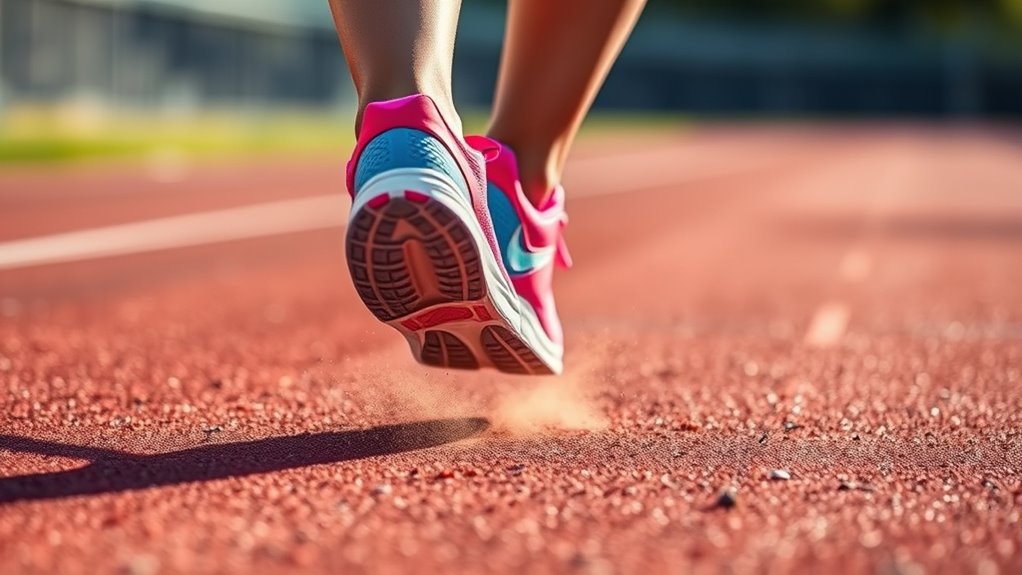
Tracking your ground-contact time accurately is essential for optimizing running performance, and there are several effective methods to do so.
- Wearable Devices: Use smartwatches or fitness trackers with built-in sensors that require proper sensor calibration for accurate data. These devices often provide real-time metrics and sync with apps for data visualization, helping you monitor progress.
- Force Plates and Treadmills: These specialized tools measure ground-contact time precisely in a controlled environment, offering detailed insights but often are less accessible for everyday use.
- Smart Insoles: These insoles incorporate pressure sensors to track contact time directly in your shoes. They connect wirelessly to apps, enabling data visualization and personalized feedback.
Choose the method that fits your goals and budget for consistent tracking.
Strategies to Reduce Ground-Contact Time for Better Performance
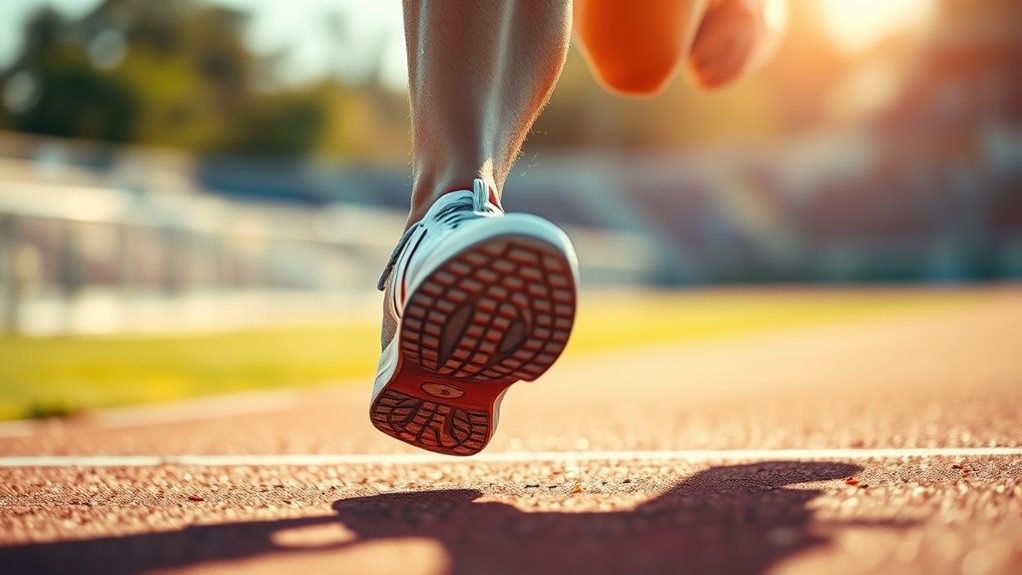
Reducing ground-contact time can markedly boost your running efficiency and speed. To do this, focus on footwear innovations designed for minimal contact and quick turnover, such as lightweight, responsive shoes that promote a faster stride. Additionally, adapt your running to terrain variations; softer surfaces like grass or trails naturally encourage quicker foot lifts, reducing contact duration. Strengthening your lower body and improving your running form also help, enabling you to push off more powerfully and lift your feet faster. Incorporate drills like A-skips or cadence training to develop a quicker stride rhythm. By combining suitable footwear, terrain awareness, and targeted exercises, you can effectively minimize ground-contact time and enhance overall performance.
Incorporating Ground-Contact Time Optimization Into Your Training
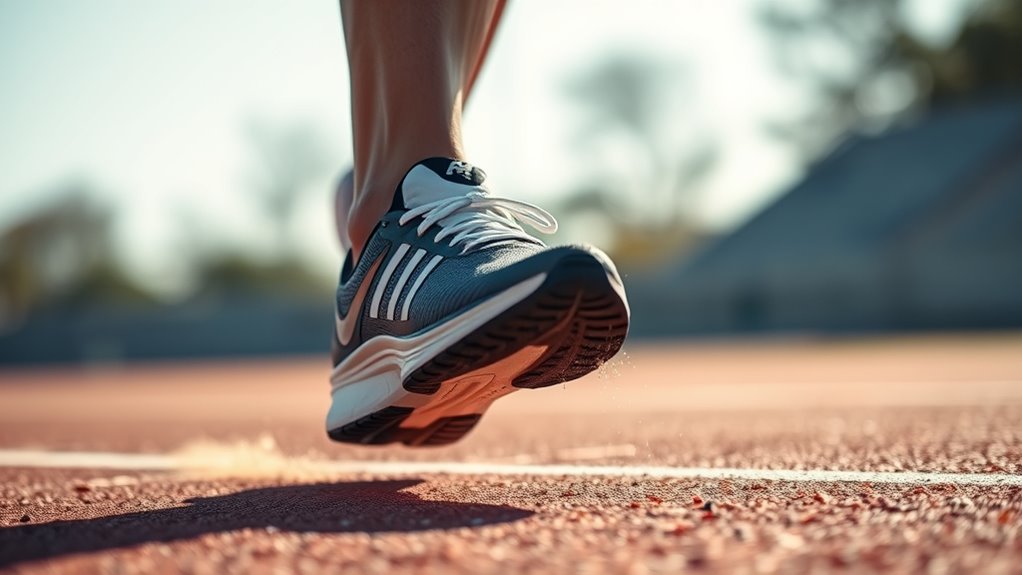
To optimize your ground-contact time, start by analyzing how long your feet stay on the ground during each stride. Adjust your stride frequency to find the right balance between speed and contact duration, and incorporate plyometric drills to improve explosive power. These methods will help you train more effectively and enhance your overall running efficiency.
Analyzing Contact Duration
Have you ever wondered how your ground-contact time influences your running efficiency? Analyzing this metric helps you identify areas to improve. First, observe your foot strike—whether it’s heel, midfoot, or forefoot—and see how it affects contact duration. Second, check your shoe cushioning; overly cushioned shoes can increase contact time, while minimal shoes promote quicker ground contact. Third, use a stopwatch or wearable device to measure your contact duration during runs. Shorter contact times often mean more efficient running, but they also depend on your foot strike and footwear. By paying attention to these factors, you can optimize your ground-contact time, leading to better performance and reduced injury risk. Focus on consistency and gradual adjustments for the best results.
Adjusting Stride Frequency
Adjusting your stride frequency is a practical way to optimize ground-contact time and improve running efficiency. By focusing on cadence adjustment, you can fine-tune your stride length without overextending it, leading to shorter ground contact and a more efficient stride. Increasing cadence typically results in quicker steps, which reduces the time your foot spends on the ground. Conversely, decreasing cadence may lengthen your stride but can increase ground-contact time and reduce efficiency. The goal is to find a balance where your stride length and cadence work together to minimize ground-contact time while maintaining comfort and form. Use drills or metronome cues to experiment with different cadences, then observe how your ground-contact time responds to these adjustments.
Enhancing Plyometric Drills
Incorporating plyometric drills into your training can substantially enhance your ability to manage ground-contact time effectively. To optimize these drills, focus on adjusting plyometric intensity, which directly influences contact duration and explosive power. First, increase plyometric intensity gradually by incorporating more challenging movements like depth jumps or single-leg hops. Second, pay close attention to footwear selection; choose lightweight, responsive shoes that support quick ground contact and reduce energy loss. Third, incorporate drills that emphasize rapid ground contact, like box jumps or bounding exercises, to train your neuromuscular system for shorter contact times. By refining these elements, you’ll improve your ability to control ground contact, leading to better performance and reduced injury risk.
Frequently Asked Questions
Can Ground-Contact Time Vary Between Different Running Terrains?
You might wonder if ground-contact time changes with terrain. It definitely can, because terrain variability affects surface impact and running mechanics. On softer surfaces like trails, your ground-contact time may increase as you absorb more shock, while on harder surfaces like roads, it tends to decrease for quicker, more efficient strides. Being aware of these differences helps you optimize your performance and reduce injury risk across various terrains.
How Does Footwear Choice Influence Ground-Contact Time?
Imagine you’re running in lightweight racing flats with minimal cushioning. Your footwear choice directly impacts your ground-contact time: lighter shoes often reduce it, allowing quicker stride turnover. Shoes with more cushioning or heavier weight can increase contact duration, possibly slowing your pace. Consider how shoe weight and cushioning influence your biomechanics; selecting the right footwear helps optimize your ground-contact time, improving efficiency and speed during your runs.
Is There an Ideal Ground-Contact Time for All Runners?
You wonder if there’s an ideal ground-contact time for all runners. While it varies based on individual factors like training consistency and stride length, shorter contact times often indicate more efficient running. Focus on maintaining consistent training and optimizing your stride to improve your ground-contact time naturally. Remember, what works for one runner may not suit another, so listen to your body and adjust your technique accordingly.
How Quickly Can I Expect to See Improvements in Ground-Contact Time?
You might see improvements in your ground-contact time within a few weeks of focused training. Enhancing your biomechanical efficiency and optimizing your stride length can accelerate progress. Consistent drills, strength work, and proper technique help you develop a quicker, more efficient stride. Keep in mind, individual results vary, but with dedication, you could notice meaningful changes in just a few sessions or months, ultimately making your running more efficient.
Does Age Significantly Affect Optimal Ground-Contact Time?
Did you know that age-related biomechanics can influence running efficiency? Your ideal ground-contact time might change as you age, impacting performance. While younger runners tend to have shorter ground-contact times, older runners may need to adapt their stride to maintain efficiency. Age doesn’t necessarily mean a decline; it just requires understanding how age and running efficiency intersect, helping you maximize your form and prevent injury.
Conclusion
By paying attention to your ground-contact time, you might open hidden potential in your running. Small adjustments could lead to faster speeds and fewer injuries—if you’re willing to dig deeper. Are you ready to challenge your limits and discover what’s truly possible? The secret lies in the seconds you spend on the ground. Don’t wait—your next breakthrough could be just a step away. Are you prepared to take it?
